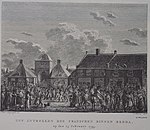Avans University of Applied Sciences
Avans University of Applied Sciences (Dutch: Avans Hogeschool) is a Dutch high ranked vocational university. It is located in three cities: Breda, 's-Hertogenbosch, and Tilburg. The school has over 30,000 students studying 40 courses in 18 institutes. There are 3,000 employees. Avans University of Applied Sciences itself was founded on January 1, 2004, as a union of Hogeschool 's-Hertogenbosch and Hogeschool Brabant in Tilburg, Breda, and Etten-Leur. Hogeschool Brabant itself was a union from 1988 of Hogeschool West-Brabant (Etten-Leur and Breda) and Hogeschool Midden-Brabant (Tilburg). The oldest branch of Avans University of Applied Sciences is the Kunstacademie in 's-Hertogenbosch, which was founded on October 1, 1812.
Excerpt from the Wikipedia article Avans University of Applied Sciences (License: CC BY-SA 3.0, Authors).Avans University of Applied Sciences
Claudius Prinsenlaan, Breda
Geographical coordinates (GPS) Address Phone number Website Nearby Places Show on map
Geographical coordinates (GPS)
| Latitude | Longitude |
|---|---|
| N 51.58371 ° | E 4.79711 ° |
Address
Avans Hogeschool | Hogeschoollaan
Claudius Prinsenlaan
4817 HN Breda
North Brabant, Netherlands
Open on Google Maps







